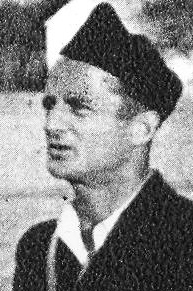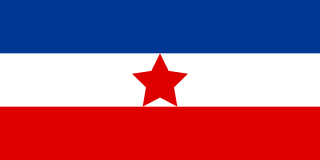
Operation Rösselsprung was a combined airborne and ground assault by the German XV Mountain Corps and collaborationist forces on the Supreme Headquarters of the Yugoslav Partisans in the Bosnian town of Drvar in the Independent State of Croatia during World War II. It was launched 25 May 1944, with the goal of capturing or killing Partisan leader Marshal Josip Broz Tito and destroying the headquarters, support facilities and co-located Allied military missions. It is associated with the Seventh Enemy Offensive in Yugoslav history, forming part of the Seven Enemy Offensives historiographical framework. The airborne assault itself is also known as the Raid on Drvar.

The Serbian Volunteer Corps, also known as Ljotićevci, was the paramilitary branch of the fascist political organisation Zbor, and collaborated with the forces of Nazi Germany in the German-occupied territory of Serbia, while loyal to the King of Yugoslavia Peter II, during World War II.

The 3rd Ukrainian Front was a Front of the Soviet Red Army during World War II.

The Russian Protective Corps was an armed force composed of anti-communist White Russian émigrés that was raised in the German occupied territory of Serbia during World War II. Commanded for almost its whole existence by Lieutenant General Boris Shteifon, it served primarily as a guard force for factories and mines between late 1941 and early 1944, initially as the "Separate Russian Corps" then Russian Factory Protective Group. It was incorporated into the Wehrmacht on 1 December 1942 and later clashed with the communist-led Yugoslav Partisans and briefly with the Chetniks. In late 1944, it fought against the Red Army during the Belgrade Offensive, later withdrawing to Bosnia and Slovenia as the German forces retreated from Yugoslavia and Greece. After Shteifon′s death in Zagreb, the Independent State of Croatia, on 30 April 1945, Russian Colonel Anatoly Rogozhin took over and led his troops farther north to surrender to the British in southern Austria. Unlike most other Russian formations that fought for Nazi Germany, Rogozhin and his men, who were not formally treated as Soviet citizens, were exempt from forced repatriation to the Soviet Union and were eventually set free and allowed to resettle in the West.

World War II in the Kingdom of Yugoslavia began on 6 April 1941, when the country was invaded and swiftly conquered by Axis forces and partitioned among Germany, Italy, Hungary, Bulgaria and their client regimes. Shortly after Germany attacked the USSR on 22 June 1941, the communist-led republican Yugoslav Partisans, on orders from Moscow, launched a guerrilla liberation war fighting against the Axis forces and their locally established puppet regimes, including the Axis-allied Independent State of Croatia (NDH) and the Government of National Salvation in the German-occupied territory of Serbia. This was dubbed the National Liberation War and Socialist Revolution in post-war Yugoslav communist historiography. Simultaneously, a multi-side civil war was waged between the Yugoslav communist Partisans, the Serbian royalist Chetniks, the Axis-allied Croatian Ustaše and Home Guard, Serbian Volunteer Corps and State Guard, Slovene Home Guard, as well as Nazi-allied Russian Protective Corps troops.

Army Group E was a German Army Group active during World War II.

The 1st Czechoslovak Army Corps, also known as Svoboda's Army, was a military formation of the Czechoslovak Army in exile fighting on the Eastern Front alongside the Soviet Red Army in World War II.

The Belgrade offensive or the Belgrade strategic offensive operation was a military operation during World War II in Yugoslavia in which Belgrade was liberated from the German Wehrmacht through the joint efforts of the Soviet Red Army, Yugoslav Partisans, and the Bulgarian Army. Soviet forces and local militias launched separate but loosely cooperative operations that undermined German control of Belgrade and ultimately forced a retreat. Martial planning was coordinated evenly among command leaders, and the operation was largely enabled through tactical cooperation between Josip Broz Tito and Joseph Stalin that began in September 1944. These martial provisions allowed Bulgarian forces to engage in operations throughout Yugoslav territory, which furthered tactical success while increasing diplomatic friction.

Vicko Krstulović was a Croatian Yugoslav communist revolutionary, the most prominent Partisan military commander from Dalmatia during World War II, and a post-war communist politician. He was an illegal communist activist during the 1920s and 1930s in Split at a time when communist sympathizers were brutally persecuted by the Yugoslav monarchy. As an officer in the Partisans during World War II, he was in charge of creating and organising the resistance movement in Dalmatia. In Socialist Yugoslavia, he worked in various government offices and was remembered for his work and contribution to his native Split.

The Partisan Long March was the redeployment of Josip Broz Tito's Partisan Supreme Headquarters and the major fighting elements of the Yugoslav Partisans across the Independent State of Croatia, from south-eastern to north-western Bosnia that commenced in late June 1942. The march followed the first large-scale joint German-Italian counter-insurgency operation in the NDH, Operation Trio, and the combined Italian-Montenegrin Chetnik offensive in Montenegro and eastern Herzegovina.

The Bratislava–Brno offensive was an offensive conducted by the Red Army in western Slovak Republic and south Moravia towards the end of World War II. The offensive was held between 25 March and 5 May 1945 using the forces of the 2nd Ukrainian Front to capture the capital of Slovakia, Bratislava, and the capital of Moravia, Brno.

The Croatian Partisans, officially the National Liberation Movement in Croatia, were part of the anti-fascist National Liberational Movement in the Axis-occupied Yugoslavia which was the most effective anti-Nazi resistance movement. It was led by Yugoslav revolutionary communists during the World War II. NOP was under the leadership of the League of Communists of Yugoslavia (KPJ) and supported by many others, with Croatian Peasant Party members contributing to it significantly. NOP units were able to temporarily or permanently liberate large parts of Croatia from occupying forces. Based on the NOP, the Federal Republic of Croatia was founded as a constituent of the Democratic Federal Yugoslavia.
The 4th Army of the Yugoslav Partisans was a Partisan army that operated in Yugoslavia during the last months of the Second World War.
The 3rd Army of the Yugoslav Partisans was a Partisan army that operated in Yugoslavia during the last months of the Second World War.
The 2nd Army of the Yugoslav Partisans was a Partisan army that operated in Yugoslavia during the last months of the Second World War.
The 5th Bosnian Corps was a Yugoslav Partisan corps that fought against the Germans, Independent State of Croatia (NDH) and Chetniks in occupied Democratic Federal Yugoslavia during World War II.

The Sarajevo Operation was an operation by the Yugoslav Partisan Army which led to the liberation of Sarajevo and Central Bosnia in March-April 1945.

The 6th Proletarian Assault Lika Division "Nikola Tesla" was a Yugoslav Partisan division formed on 22 November 1942. It was formed from the 1st, 2nd, and 3rd Lika Brigades. On 11 November 1943, it became part of the 4th Corps and later a part of the 1st Corps. It operated in Dalmatia until November 1943 when it crossed into Bosnia, later it fought in Serbia and on the Syrmian Front. From October 1944, the 22nd Serbian Kosmaj Brigade also fought as part of the division, and in December 1944 an Artillery Brigade was formed within the division.

Boris Mikhailovich Skvortsov was a Red Army major general of tank forces who rose to command the 5th Guards Mechanized Corps during World War II.

The 29th (Herzegovinian) Division was a Yugoslav Partisan division formed on 16 November 1943. It was formed from the 10th, 2nd and 3rd Herzegovinian Brigades which had a total strength of 1,567 fighters. Since its formation, the 29th Division was a part of the 2nd Corps.














